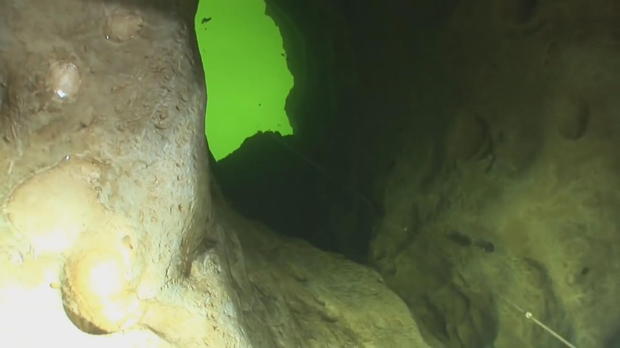The deaths of two experienced Florida divers is prompting new calls to close a well-known cave diving site. The underwater cave system known as Eagles Nest has been called the “Mount Everest” of the sport.
Located in a remote wilderness area about an hour north of Tampa, Eagle’s Nest draws divers from around the world and reaches hundreds of feet down. It is considered a very advanced dive, meaning only those with the proper training and certifications should attempt it.
Even then, it is still dangerous -- both men who died here were skilled diving instructors, reports CBS News correspondent Manuel Bojorquez. From the surface, Eagle’s Nest appears serene, but looks can be deceiving.
Divers have lost their lives exploring the rocky maze of dark crevices and tunnels underwater. A grim sign at the mouth of the cave warns divers to turn back.“I guarantee you there was nothing left for them to do in the end,” said Ron Rittenmeyer. He and his son, Chris, had the proper training and was always careful.

“My son typically dove what he thought was his limit. I believe in his heart he did this dive fully expecting that he would be back,” Rittenmeyer said.
Chris and his friend Patrick Peacock failed to return from their dive Saturday afternoon. The sheriff said their bodies were recovered near each other Sunday, 260 feet down.
“He would never leave him. The other guy would never leave Chris. I’m proud of him for that. And I’m also saddened by that,” Rittenmeyer said.
“You think that maybe if one was in trouble, the other one wouldn’t leave the other one behind?” Bojorquez asked.
“Never. Never. That’s not the way they’re trained, and that’s not their character,” Rittenmeyer said.
The underwater cave system at Eagle’s Nest is composed of three different tunnels. Parts of it are more than 300 feet below the surface.
Rittenmeyer and Peacock were both experienced divers. They had been in the depths of Eagle’s Nest before, as recently as Friday -- part of a weekend-long plan to explore the cave.
“It wasn’t like they were a couple of yahoos that just went in there with no training or anything else,” said Joseph Citelli, chairman of the National Speleological Society Cave Diving Section. “Done properly, it’s a very safe endeavor, but so is skydiving.”
From 2010 to 2013, there were 12 cave diving deaths in the U.S., including two at Eagle’s Nest. Ten people have died there since 1981.
The cave was closed off in 1999. Divers lobbied successfully to reopen it in 2003.
Ron Rittenmeyer, who is also a diver, wants it to remain that way.
“There’s always something that can go wrong. There just is,” Rittenmeyer said.
“How are you and your family coping right now?” Bojorquez asked.
“I don’t know if we are. You should precede your children in death. That is the natural order,” Rittenmeyer said. “So to have a 38-year-old son be gone it’s – I can’t even describe it.”
The Divers Alert Network said the majority of cave diving deaths in the U.S. involve trained divers. Exactly what led to the two men’s deaths is unknown at this point, but the Professional Association of Diving Instructors told “CBS This Morning”: “The central message remains that you must be trained as a cave diver to go into underwater caves.”
© 2016 CBS Interactive Inc. All Rights Reserved.


